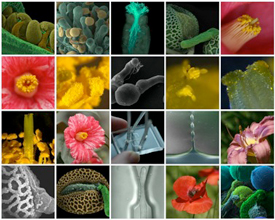A fingernail-sized laboratory to study sperm release

For human reproduction, a bed or sofa is about the right size, but for humans who study plant reproduction, a microchip the size of a fingernail is perfect. Muthukumaran Packirisamy, a professor in the Department of Mechanical and Industrial Engineering, recently used his lab-on-a-chip technology for a collaborative study with colleagues at l’Université de Montréal. The aim was to find out what conditions are optimal for a plant’s pollen tube to release sperm.
“The huge value of lab-on-a-chip technology is that you can create a controlled environment to study things on a nano level,” explains Packirisamy. “It can be used to study blood cells, neurons, or — as in this case — plant sperm.”
Packirisamy and his colleagues, including lead collaborator, Anja Geitmann at UdeM, were able to design a lab-on-a-chip in which the plant cell was forced to squeeze through tiny apertures made of material softer than the plant’s cell wall. Controlling the growth and direction of the cell while also using such surrounding structures as sensors made it possible to estimate the pressure inside the cell. This gave the researcher the ability to learn what pressures were optimal for sperm release.

This recent study is the latest example of how Concordia engineers contribute to the life sciences. Much of this work is conducted at the Optical-Bio Microsystems Laboratory, which Packirisamy directs. The technology developed here is a prime example of what has been called the “Third Revolution” in the life sciences, a phrase coined by Nobel Laureate Phillip Sharp to describe the interdisciplinary collaboration of engineers, physicists and biologists.
Packirisamy’s research in this area, called micro-electro-mechanical systems (MEMS), integrates micro-fluidics with micro-photonics and nano features. In layman’s terms, this is the science of designing, manufacturing, and formulating devices and processes that deal with miniscule volumes of fluid, combined with directing and manipulating light on a microscopic scale.

Holding the position of Concordia Research Chair on Optical-Bio Microsystems, Packirisamy also leads research in the area of BioMEMS, an application of micro-nanotechnologies in biology. He co-authored the book Bio-MEMS: Science and Engineering Perspectives, published in 2011 by CRC Press. This is an authoritative and comprehensive exploration of this new field of inquiry.
This study, called “Quantification of Cellular Penetrative Forces Using Lab-on-a-chip Technology and Finite Element Modeling,” was co-authored by Amir Sanati Nezhad, Mahsa Naghavi, Muthukumaran Packirisamy, Rama Bhat and Anja Geitmann, was published in the proceedings of the national Academy of Sciences and funded by the Fonds de recherche du Québec — Nature et technologies.
Related links:
• Joint news release from UdeM and Concordia
• Faculty of Engineering and Computer Science
• Muthukumaran Packirisamy's profile on Research @ Concordia